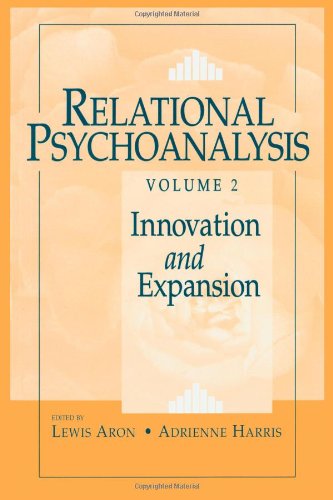Relational Psychoanalysis Volume 2 Innovation and Expansion 1st Edition by Lewis Aron, Adrienne Harris 9780881634075 0881634077
$50.00 Original price was: $50.00.$35.00Current price is: $35.00.
Relational Psychoanalysis Volume 2 Innovation and Expansion 1st Edition by Lewis Aron, Adrienne Harris – Ebook PDF Instant Download/Delivery:9780881634075, 0881634077
Full download Relational Psychoanalysis Volume 2 Innovation and Expansion 1st Edition after payment

Product details:
ISBN 10: 0881634077
ISBN 13: 9780881634075
Author: Lewis Aron, Adrienne Harris
The “relational turn” has transformed the field of psychoanalysis, with an impact that cuts across different schools of thought and clinical modalities. In the six years following publication of Volume 1, Relational Psychoanalysis: The Emergence of a Tradition, relational theorizing has continued to develop, expand, and challenge the parameters of clinical discourse. It has been a period of loss, with the passing of Stephen A. Mitchell and Emmanuel Ghent, but also a period of great promise, marked by the burgeoning publication of relational books and journals and the launching of relational training institutes and professional associations. Volume 2, Relational Psychoanalysis: Innovation and Expansion, brings together key papers of the recent past that exemplify the continuing growth and refinement of the relational sensibility. In selecting these papers, Editors Lewis Aron and Adrienne Harris have stressed the shared relational dimension of different psychoanalytic traditions, and they have used such commonalities to structure the best recent contributions to the literature. The topics covered in Volume 2 reflect both the evolution of psychoanalysis and the unique pathways that leading relational writers have been pursuing and in some cases establishing.
Relational Psychoanalysis Volume 2 Innovation and Expansion 1st Table of contents:
Introduction
What Kind of Theory Is Relational Theory?
The Relational Tradition, Volume Two: Topics
References
Therapeutic Action
The Intimate Edge in Therapeutic Relatedness (1974)
Editors’ Introduction
The Intimate Edge in Therapeutic Relatedness*
I
II
III
References
Afterword
References
Holding Something Old and Something New* (1996)
Editors’ Introduction
Holding: Something Old and Something New
The Holding Metaphor in a Relational Context
The Evolution of the Holding Metaphor
A Relational Holding Model
Illusion and the Coconstructed Holding Metaphor
Holding and the Analyst’s Subjectivity
Holding as Enactment
The Limits of the Holding Metaphor
Holding and Collaborative Psychoanalytic Work
Illusion and the Holding Metaphor
References
Afterword
Old and New Objects in Fairbairnian and American Relational Theory (1998)
Editors’ Introduction
Old and New Objects in Fairbairnian and American Relational Theory1
Constructivism and the Continuum of New-Old Objects
Analysts’ Obstacles to Seeing Newness
Patient’s Inner Obstacles to Seeing Newness
Disclosure and the Continuum of New–Old Object
Holding the Psychic Future: Future Object and Self
References
Afterword
References
Why the Analyst Needs to Change Toward a Theory of Conflict, Negotiation, and Mutual Influence in the Therapeutic Process (1998)
Editors’ Introduction
Why the Analyst Needs to Change Toward a Theory of Conflict, Negotiation, and Mutual Influence in the Therapeutic Process*
Conflict as an Essential Constituent of Relating
The Adaptive Resistance to Influence in the Analytic Relationship
Nancy and the Analyst’s Newborn Child
Tanya: Paying to Be Cared About
How the Analytic Situation Heightens the Experience of Conflict and Deception
The Therapeutic Transference as a “Mimicry” of the Parent–Child Relationship
The Patient’s “Innate Skepticism”
Transference as an Adaptive Probe
Edward and His Analyst
Deepening Conflicts with the Analyst’s Identity
Implications
Projective Identification and Enactments
The Intrinsic Ambiguities of Empathy
“Throwing Away the Book,” Self-Interest, and the Process of Achieving “Authenticity”
Some Concluding Thoughts
References
Afterword
References
Show Some Emotion Completing the Cycle of Affective Communication (1999)
Editors’ Introduction
Show Some Emotion: Completing the Cycle of Affective Communication*
Psychoanalysis and Affective Theory
Written on the Body
Is Affect Inhibition Overvalued?
Emotion and Cognition
What Is Emotional Memory?
Affect, Alexithymia, and Trauma
Gender Differences
Clinical Implications
References
Afterword
References
Psychoanalytic Supervision The Intersubjective Development (2000)
Editors’ Introduction
Psychoanalytic Supervision: The Intersubjective Development*
Countertransference Cannot be Relegated to the Candidate’s Analysis
Supervision as a Crossroads of a Matrix of Object Relations
The Conflict-Generating Triadic Structure of the Analytic-Supervisory Situation
Difficulties in Supervision as a Topic of Supervisory Discourse
The Triad in the Context of Institutional Dynamics
The Boundaries Between Supervision and Analysis
Transitional Space Evolving in Supervision
A Broad Range of Options
References
Afterword
References
On Misreading and Misleading Patients Some Reflections on Communications, Miscommunications, and Countertransference Enactments (2001)
Editors’ Introduction
On Misreading and Misleading Patients: Some Reflections on Communications, Miscommunications, and Countertransference Enactments*
References
Afterword
Relational Perspectives on Development
Representation and Internalization in Infancy Three Principles of Salience (1994)
Editors’ Introduction
Representation and Internalization in Infancy: Three Principles of Salience*
Why Three Principles?
Self- and Object Representations Are Rooted in Interaction Structures
The Principles of Salience and Self- and Object Representations
The Principle of Ongoing Regulations
Ongoing Regulations: Integration of Mutual and Self-Regulation
The Principle of Disruption and Repair
The Principle of Heightened Affective Moments
Internalization and Interactive Regulation
Conclusion
Acknowledgments
References
Afterword*
References
Mentalization and the Changing Aims of Child Psychoanalysis (1998)
Editors’ Introduction
Mentalization and the Changing Aims of Child Psychoanalysis*
A Widening Scope for Psychoanalysis?
Mentalization: A Protective Factor and a Focus of Psychotherapy
Self, Action, and the Body
Empirical Support
Enhancing Reflective Processes
Play Helps Children to Strengthen Impulse Control and Enhance Self-Regulation
Working in the Transference
Conclusion
References
Having a Mind of One’s Own and Holding the Other in Mind Commentary on Paper by Peter Fonagy and Mary Target* (1998)
Editors’ Introduction
Having a Mind of One’s Own and Holding the Other in Mind: Commentary on Paper by Peter Fonagy and Mary Target*
Therapeutic Efficacy
Reflective-Functioning
Fostering Reflective-Functioning
Transmission of Attachment Security and Its Relation to Reflective-Functioning
The Widening Scope of Child Psychoanalysis
References
The Two–Person Unconscious Intersubjective Dialogue, Enactive Relational Representation, and the Emergence of New Forms of Relational Organization (1999)
Editors’ Introduction
The Two–Person Unconscious: Intersubjective Dialogue, Enactive Relational Representation, and the Emergence of New Forms of Relational Organization*
Part 1: Developmental Origins of Enactive Relational Procedures
Part II: Enactive Relational Representation and the Process of Change
Conclusions
References
Social and Cultural Dimensions of Relationality
Psychoanalysis and the Urban Poor (1993)
Editors’ Introduction
Psychoanalysis and Urban Poor*
The Theoretical Background of this Paper
The Case of Linda
Theoretical Perspectives
The Case of Nancy
Administrative Issues
References
Afterword
References
Perversion Is Us? Eight Notes (2001)
Editors’ Introduction
Perversion Is Us? Eight Notes*
Note 1. How to Talk About This: Anxiety and Disgust
Note 2. Pathology and Suffering, Shame and Pain
Note 3. What Is a Perversion?
Note 4. Accepting/Disowning the Perverse in the Normal
Note 5. Fixity and Flexibility
Note 6. Fetishism and the Paradigm Shift
Note 7. Relatedness, Aggression, and Social Control
Note 8. Shelter from the Storm?/Rabbit in a Briar Patch
References
Afterword
References
Race, Self-Disclosure, and “Forbidden Talk” Race and Ethnicity in Contemporary Psychoanalytic Practice (1997)
Editors’ Introduction
Race, Self-Disclosure, and “Forbidden Talk’: Race and Ethnicity in Contemporary Psychoanalytic Practice*
Clinical Illustration
Race, Ethnicity, and Culture in Psychoanalytic Treatment
Contemporary Psychoanalytic Practice and Multicultural Perspectives
References
Afterword
References
More Life Centrality and Marginality in Human Development (2001)
Editors’ Introduction
More Life: Centrality and Marginality in Human Development*
The Invert, Reality, Centrality, and Determinism
The Queer, Association, Marginality, and Complexity
From Three Essays to Five Quasi-Axioms
References
Afterword
Affinity and Development
Developmental Models as Tools
References
Author Index
Subject Index
People also search for Relational Psychoanalysis Volume 2 Innovation and Expansion 1st :
relational psychotherapy pdf
relational psychoanalytic psychotherapy
relational psychoanalysis theory
a relational perspective suggests that
the relational revolution in psychoanalysis and psychotherapy
Tags:
Lewis Aron,Adrienne Harris,Relational Psychoanalysis



